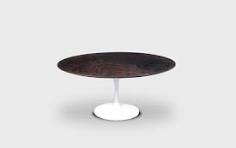The coffee table, a ubiquitous fixture in modern living rooms, boasts a surprisingly rich and varied history that spans centuries. While the concept of a low table for serving coffee and other refreshments dates back to 18th-century Europe, the modern coffee table as we know it today is a distinctly 20th-century innovation. This evolution reflects broader shifts in societal norms, technological advancements, and changing conceptions of the home and domestic life.
In the 1920s and 1930s
In the 1920s and 1930s, low tables experienced a surge in popularity as a central feature of social gatherings and cocktail parties. These early precursors to the modern coffee table were often ornate and formal, mirroring the glamorous and sophisticated aesthetic of the Art Deco era. Crafted from luxurious materials like marble, glass, and exotic hardwoods, they showcased intricate carvings, inlays, and other decorative flourishes. Rather than mere furniture, these tables served as status symbols, reflecting the wealth and refinement of their owners.

The post-World War II era marked a pivotal turning point in the evolution of the coffee table.
As suburbanization took hold and the middle class expanded, there was a growing demand for furniture that prioritized comfort, practicality, and versatility.
This shift was fueled by changes in lifestyle and domestic norms, as the living room increasingly became a space for relaxation and informal gatherings rather than formal entertaining.
Noted Designers
Designers of the mid-20th century, such as Isamu Noguchi and Eero Saarinen, played a crucial role in shaping the modern coffee table. Their iconic designs emphasized simplicity, functionality, and clean lines, reflecting the broader aesthetic principles of modernism. Noguchi’s 1948 design for Herman Miller, featuring a simple rounded wood top on three tapered legs, became an instant classic of modern design. Its understated elegance and versatility made it an ideal centerpiece for the contemporary living room.

Saarinen’s Tulip Table, introduced in the 1950s, was another groundbreaking design that reimagined the coffee table. Featuring a cast aluminum base with a round or oval top, the Tulip Table was part of a larger collection of pedestal-based furniture designed to eliminate clutter and create a sense of openness and flow. This design ethos was perfectly in tune with the era’s emphasis on spaciousness and visual lightness.

The latter half of the 20th century saw a proliferation of coffee table designs in a staggering array of styles, materials, and forms. The 1960s and 1970s were a particularly fertile period, with designers experimenting with new materials like glass, metal, and plastic. This led to a wide range of designs, from minimalist and sleek to ornate and decorative, reflecting the era’s eclecticism and playfulness.
Today
Today, the coffee table remains an indispensable fixture in the modern living room, serving both practical and aesthetic purposes. It’s a surface for placing drinks and snacks, a platform for displaying decorative objects and personal mementos, and a workspace for everything from laptops to board games. More than just a piece of furniture, the coffee table has become a hub of domestic life, a testament to our evolving needs and aspirations for the home. A handyman’s dream to maintain
As design continues to evolve, it will be fascinating to see how the coffee table adapts to new trends and technologies. Whether it’s the incorporation of charging stations for our devices, the use of sustainable and eco-friendly materials, or the integration of smart home technology, the coffee table is sure to remain a dynamic and essential element of the modern living room. Its enduring popularity is a tribute to its versatility and the central role it plays in our daily lives.